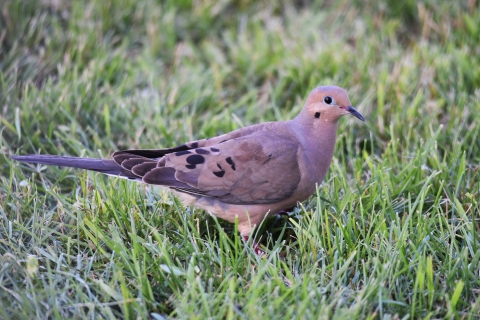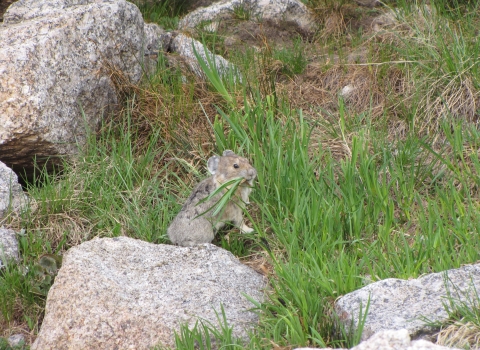Fellowship, tradition, and enjoying the outdoors are all words people use to describe why they appreciate dove hunting. While some hunters have the good fortune to be able to access private dove fields, others rely on public land. Utilizing Wildlife Restoration Funds, Georgia’s Wildlife Resources Division cultivates over 3,000 acres of dove fields for public hunting.
The autumn season elicits excitement. For some, that comes from the return of college football; for others, relief from the summer heat marks the season's change. For Laurel Barnhill, it signals the beginning of dove season.
Laurel has always had a passion for bird hunting. She grew up hunting with her parents and fondly recalls spending hours in the field, bonding over their shared love of the outdoors. Her father proudly wore an “NRA Safe Hunter” patch on his vest. Laurel learned the value of safe and ethical hunting from her parents.
These experiences in the field grew her love of the outdoors and ultimately led her to choose a career centered around wildlife conservation. She now serves as Chief of Staff for the U.S. Fish and Wildlife Service Southeast Region.
This love of the hunting and the outdoors has also been a strong connection point for Laurel and her husband, Haven Barnhill. Haven, who also serves the U.S. Fish and Wildlife Service Southeast Region through his work as Deputy Regional Forester, has been an avid dove hunter for the majority of his life. His lifelong dream was to own his own property and plant a dove field for friends and family to enjoy.
Together, they have turned this dream into reality.
For almost two decades, Laurel and Haven have cultivated a 12-acre dove field on their property just outside of Athens, Georgia. On the opening day of Georgia’s dove season—typically the first Saturday of September—they invite family and friends to enjoy the fruits of their labor and participate in a dove hunt.
Folks arrive around noon and share lunch before heading to their spot on the field. After a few hours of shooting, the men, women, and children reconvene for dinner and fellowship.
This opening day tradition means the world to Laurel. For her, bird hunting represents a time of tradition and togetherness.
“It’s not about how many birds anybody kills,” she says. “It’s about sharing the experience of being together on a Saturday afternoon.”
The hunt is the only time Laurel and Haven can spend quality, face-to-face time with some of their friends and family members.
Severalof them have literally grown up hunting this field.
“I’ve watched my nephew grow from four feet tall when he started hunting here to now being taller than I am,” Laurel laughs. “To pass these hunting traditions down is really poignant to me.”
While Laurel is grateful she can provide a field for her friends and family, she recognizes that not everyone has the opportunity for private hunting.
“Having public lands available and multiple dove fields across the state is critical for people to enjoy a safe, quality hunt,” she says.
Providing public hunting access requires people, gear, and money. Fortunately, Georgia’s Wildlife Resources Division (WRD) has access to grant funds from the U.S. Fish and Wildlife Service’s Wildlife Restoration Program.
Authorized by the Wildlife Restoration Act of 1937, the program apportions money generated from taxes on firearms, ammunition, and archery equipment to state wildlife agencies to pay for conservation projects. The Service administers the program and covers 75 percent of the costs, with the state responsible for the remaining 25 percent. These projects include habitat and species management, research, land acquisition, facility construction, and hunter education.
Wildlife Restoration funds are crucial for cultivating and maintaining dove fields. They help cover seed, equipment, and the many hours of labor spent tending the fields.
WRD currently maintains over 3,000 acres of managed dove fields scattered throughout the state, ensuring that most hunters have access to dove hunting opportunities within driving distance. Some public dove fields even exist on private land, made available through WRD’s Voluntary Public Access (VPA) program.
The VPA program, partially funded by Wildlife Restoration funds, allows private landowners to lease property to WRD. With 93% of Georgia’s land in private ownership, VPA significantly expands opportunities for public recreation.
Maintaining quality dove hunting also involves monitoring the species’ population. Biologists and wildlife technicians spend countless hours trapping and banding birds, with Wildlife Restoration Funds helping pay for labor costs.
First, biologists and technicians select a location. Then they bait the area, often with wheat or corn. As the birds grow accustomed to a baited spot, they lay down a cage with tunnels so the birds can reach the feed. Once inside, the birds cannot escape. Biologists and technicians then return to the cage to band, sex, and age the individual birds before releasing them.
Bird banding involves placing a small, numbered, bracelet-like tag on each bird. If a hunter harvests the bird, he or she can report the identification number to www.reportband.gov. This data helps the Service learn about the birds’ breeding and wintering homes, behavior, migration, survival, and reproduction.
This information assists the Service in offering recommendations to state wildlife agencies regarding bag limits and season lengths for hunting, ensuring the maintenance of a healthy dove population.
These population surveys benefit both private and public land hunters. Without adequate monitoring, dove hunting as we know it wouldn’t exist.
Like Laurel, many hunters use dove season as a way to spend time with family and friends and view it as a tradition to pass down. Wildlife Restoration Funds play an important role in providing public access and managing wildlife and preserving the tradition for years to come. If you don't have an annual outdoor tradition in your family or friend group, perhaps it's time to look at the public land near you and starting one!







